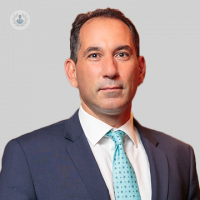NETs – what is a neuroendocrine tumour?
Written in association with:NETs (neuroendocrine tumours) which are also called 'carcinoids', consist of neuroendocrine cells, which already exist in our bodies. These cells form glands, such as the parathyroid or adrenals, which regulate our hormones and send messages around the body. Dr Christos Toumpanakis, world-class expert in NETs, explains more.

Neuroendocrine cells are found everywhere in the body, but the most common location is the gastrointestinal system, such as the food pipe, stomach, gut, and pancreas. NETs are found in the areas that the cells are more concentrated.
What are neuroendocrine tumours?
It is important to remember that although NETs are cancerous tumours, they are rare (although their incidence is on the rise). NETs are different to tumours found in the rest of the body, as they are slow growing. There are also different types of NET – some will not spread and never grow back, while some may grow back after removal, and some behave like regular cancers, spreading to other parts of the body (liver, lymph nodes, bones). NETs can co-exist with a patient’s body for many years, unlike other cancers.
NETs can also develop outside the digestive system, for example in the thyroid, or in the lungs. They may secrete hormones, which is usually the cause of patients’ symptoms.
What are the symptoms of a neuroendocrine tumour?
If the tumour secretes hormones, some symptoms the patient may experience are related to 'carcinoid syndrome', which consists of wheezing, diarrhoea, and flushing of the face. This can also develop into 'carcinoid heart disease', which usually damages the valves of the right side of the heart. In that case, patients may develop swelling in the legs, or shortness of breath.
If the tumour does not secrete hormones, symptoms are usually vague, and therefore do not indicate specific diseases or problems. This means tumours can often be misdiagnosed. Symptoms like this include dyspepsia (indigestion), chronic abdominal pain, and weight loss, which are symptoms compatible with irritable bowel syndrome (IBS). This can go on for years, as the tumours grow so slowly.
How are neuroendocrine tumours diagnosed?
NETs are diagnosed through blood tests, urine tests and imaging studies (including CT/MRI and nuclear medicine scans) to find out the location of the primary tumour and also if/where the tumour has spread. A biopsy (taking a small sample of tumour tissue) is also required.
How is a neuroendocrine tumour treated?
The doctor will usually take several steps in order to treat the tumour:
- The first is to address and treat the patient’s symptoms, especially those which are associated with secretion of hormones. The medications that are usually used for that purpose are also special hormonal agents, which are able to inhibit the hormonal secretion by the tumour.
- Once the patient’s symptoms are under control – as they are usually the biggest immediate problem the patient faces – the specialist can discuss with the surgeons whether the resection of the primary tumour, and indeed any metastatic lesions (places to which the cancer has spread) can be safely removed.
- In the case that the tumour cannot be removed, the next treatment step seeks to control the spread of the tumour and keep it stable. There are several medications available for that purpose.
- In all cases, it is important for the doctor to make sure that patient’s quality of life is significantly improved or at least maintained, as this can make a huge difference to the patient.


